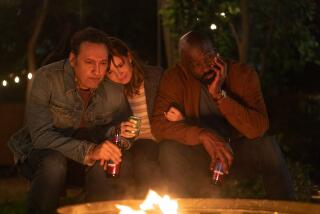At 16, Christine Olson lost her...
- Share via
If you want to talk about odds or bell curves or patient profiles culled from the medical literature, do so out of earshot of Christine Olson. She’ll have none of it. Neither will her family, a particularly stubborn lot who won’t countenance bad news.
They’ve had enough. First there was the accident on July 4th three years ago, way out in the desert near Blythe. Christine, then 16, was driving her ’73 Mustang, tailing her dad. It was about 5:30 in the morning, when it was cool.
The two were headed from Orange County to Denver, the city that until a few months earlier had been their home. Christine had her seat belt on and the radio blaring KIIS-FM when she fell asleep. Then her foot pressed the gas pedal to the floor.
The Mustang flew, literally sailing off the road before a boulder smacked it down. Her father looked in his rear-view mirror and saw only a rising cloud of dust.
You want odds? Christine Olson, now 19, should be dead. She was in a coma for two months. She couldn’t even swallow on her own. Then there were the surgeries, six inside her skull alone. The right side of Christine’s brain no longer exists.
Her neurosurgeon says he did surgeries never done before, if for no other reason than because there was nothing to lose. During one, Christine’s swollen brain was left open for four days.
The complete inventory of Christine’s injuries is too long to list here. Suffice to say that she cannot walk or talk. That is, not yet.
If you want to understand Christine’s story, you must put aside conventional notions about odds. You must, instead, think of her graduating on time with her high school class in Huntington Beach. Or about delaying, by sheer force of will, yet another brain surgery because she didn’t want to be a bridesmaid in her brother’s May wedding with a shaved head.
“That’s Christine,” her family says.
And now medical professionals are saying as much themselves. Far from counting her out, they are proffering hope where they might not have before, especially for the daughter of a carpenter with no insurance and no means to pay. They are essentially working for free.
“She’s sort of a miracle,” says the surgeon who is about to operate on her now.
Which is why Christine is lying in the surgical holding area of Western Medical Center in Santa Ana, an IV in her ankle and arm and her homemade alphabet board resting on her chest.
She takes a manicured fingernail and spells out her thoughts. “T-h-i-s i-s t-h-e f-i-r-s-t s-u-r-g-e-r-y I-m n-e-r-v-o-u-s a-b-o-u-t,” her mother, Judy Olson, reads aloud.
There is cause. The surgery Christine is about to undergo is new and tricky and its objective much loftier than most. And Christine must remain awake because her active participation is key. Her hopes are not only up, they are floating somewhere over her head.
Dr. Stanley Lowenberg, an otolaryngologist and head and neck surgeon, aims to make Christine talk.
Lowenberg is one of a handful of physicians nationwide who implant small blocks of plastic, called Silastic, against paralyzed vocal cords in an effort to nudge them into a position that will allow a patient to speak.
He has performed the surgery twice, with success, but on patients whose prognosis and general health were very good.
“I would have never chosen Christine as a patient,” he says. “She’s sort of on the far end of the bell curve. She has major neurological impairment. She’s had a stroke. She has scarring. She doesn’t have much of a neck. . . . What you are dealing with is someone who came back from death, essentially.”
But on the advice of his friend and colleague Dr. Mark Krugman, Lowenberg met Christine and her family before saying no. Krugman, a voice specialist who has been seeing Christine for a year, had been touched by his patient’s determination and spunk, not to mention her jokes.
The night before this morning’s surgery, this young woman who has always loved to talk spelled out what she intends to be her first words in the operating room.
“I-t-s a b-a-d h-a-i-r d-a-y,” she wrote.
Lowenberg met Christine early last month and he, too, was moved.
“My feeling was here’s somebody who has made unbelievable progress. I don’t know everything, but what I do know is phenomenal. And what her parents are like . . . her mom. She’s just marvelous. With people like that, you can’t lose. I got on the bandwagon right away, after just meeting her for the first time.
“I knew that whatever I could do for her would be worthwhile.”
Lying in the surgical holding area last month Christine’s mind is on something else. “T-h-e-s-e p-e-o-p-l-e a-r-e n-u-t-s g-e-t-t-i-n-g m-e u-p t-h-i-s e-a-r-l-y a-n-d e-x-p-e-c-t-i-n-g m-e t-o s-t-a-y u-p,” she spells out.
Judy Olson, her daughter’s full-time caretaker, turns to a visitor. “The only thing I think is unfair about this surgery is they won’t be able to put a zipper in,” she says.
Finally, Christine is rolled into the operating room. Only a moment earlier, she had turned serious again, just before the anesthesia that deeply relaxes her takes effect. She asked if she could change her mind.
“Honey, we’ve waited and talked about this for so long . . .” says Lynn Olson, her dad.
*
The operating room is a temple of medical high tech. The equipment alone took nearly two hours to set up. There were problems positioning the endoscope, a flexible tube that includes a tiny camera lens, through Christine’s nostril and down the back of her throat. Its placement must be exact.
The color images it captures are projected on the screen of what looks like a sophisticated home computer, a rhino-laryngeal stroboscope.
On the screen, Christine’s vocal cords appear as thin white tubes formed into a wide “V.” Protecting the cords is the epiglottis, pink tissue that flaps rhythmically up and down.
Christine’s right, paralyzed cord is projected on the left side of the screen. In order to talk, a person’s vocal cords must touch, but Christine’s right cord does not move. It is vibration that germinates a voice.
By cutting away thyroid cartilage and inserting the Silastic implant, Lowenberg hopes to move her right cord within striking range of the left. If it works, there should be sound.
Next to this stroboscope stands a similar machine that projects a still image of Christine’s vocal cords from a previous “scope” in May. Lowenberg and his assistant, Dr. Krugman, will refer to both when they make decisions in this room that they hope will change Christine’s life.
*
The surgery takes time. Minutes turn to hours and then add up beyond that. Christine, her eyes closed, occasionally groans.
The surgeons have made about an inch-long incision in the front of her throat, but there is little blood because the electric needle that cuts the skin cauterizes as it goes.
“Christine, swallow once,” the anesthesiologist says. “That’s good. Now take nice deep breaths.” The effect on her vocal cords shows on the screen.
“Relax your head, Christine,” the anesthesiologist says. “You’re doing fine.”
But there is pain. Christine manages to convey this with groans and body jerks that startle the doctors and nurses who hover nearby. One nurse places her hand under the sheet to touch Christine’s leg. She leaves it there, to offer what comfort it can.
The anesthesiologist administers more drugs, but not too much. Christine must be kept awake.
Lowenberg asks for a depth gauge so that he can match the size of the Silastic implant with Christine’s larynx. He has pre-measured some implants but he must fine-tune them here. He takes a scalpel and whittles one down to size. A shield placed over Christine’s chest is his work table now.
“What I’m going to do is shave the implant, put one in and see how we’re doing,” Lowenberg tells Krugman.
“Yes, that’s the way to do it,” Krugman says. “You have to go by the seat of your pants.”
“This is what’s going to go against her cord,” Lowenberg says, showing his colleague the implant in his hand. It is notched so that once in place, it will not move.
“We’ll just rotate this guy in,” Lowenberg says.
Only this guy doesn’t quite fit.
Christine moans, and jerks. Krugman asks for topical anesthesia and dabs it inside her opened larynx.
Lowenberg tries again, shaving down another implant. The faces of the surgeons and nurses are tense. Krugman looks especially tired. He squints his eyes and under his surgical mask, he staves off a yawn.
“Christine, hold still, dear,” Lowenberg says. “We’re almost done.”
Then, finally, the implant is in place. Lowenberg’s eyes are fixed on the screen that is showing what his hands are doing inside Christine’s throat.
“Try to swallow for us, Christine,” he says. “It’s real important.”
“If you give a good swallow, we may be done,” Krugman adds.
And then, Christine does.
The mood in the operating room lightens, just a touch. Krugman asks Christine if she can say “e,” if she can say, “i.” But nothing comes out.
“The secretions are a problem,” Lowenberg says.
There are efforts to clear them and for the first time since her accident, Christine gives a deep cough. The endoscope nearly falls from the vise that is holding it up.
And then there is a voice.
“What did you say, Christine?” Lowenberg asks. “Would you repeat that please?” “Can you stick out your tongue?” Krugman says, excited.
“What?” Lowenberg says to his patient. “I like that sound, Christine!”
“She’s got a better voice,” Krugman says.
Then both surgeons look at the screen to see what technology, surgical skill and plain old willpower have done.
“OK, Stan. Oh yeah,” Krugman says.
“Oh, wow. She’s closed,” Lowenberg goes on. “You got it all on tape? Great.”
“It’s a take,” says Krugman.
“Yeah. Good one.”
But Christine can’t stand it. It is not anesthesia that she wants now. She wants to say more. She makes a strong sound. It doesn’t sound like, “It’s a bad hair day,” but with Christine nobody is ruling anything out.
“Christine, try not to use your voice right now. Give it a rest. You don’t want to get swelling,” Lowenberg says.
Dee Parker, Christine’s speech therapist, who is operating the stroboscope, leans toward a visitor and says, “You don’t understand. She’s waited so long to use her voice!”
The mood is weary exhilaration now. The surgeons suture Christine’s throat, and she is wheeled into the recovery room, and shortly thereafter, into intensive care.
Her family is there to meet her. Her regular neurosurgeon, Dr. Ali Tahmouresie, the same Palm Springs physician who attended her the night of the accident that according to the odds, should have landed her in the grave, has been told that the surgery looks like a success.
Christine is propped up in bed. She is groggy, in pain, but she reaches for her alphabet board, keeping her promise to her doctor not to talk until a week later.
“I was so pissed,” she writes. “The recovery nurse kept running her hand through my hair.”
As for what it was, exactly, that Christine said in the operating room. She writes, “E-n-o-u-g-h.”
Christine’s brother, Mark, picks up the lighted oxygen monitor attached to her finger and tells his sister that she’s just like E.T.
And, just for a minute, Christine instinctively moves her lips. “Phone home,” she mouths.
*
Christine was released from the hospital the next morning, after waking up early to do word search puzzles. Lowenberg stood at the foot of her bed, smiled, and shook his head.
“You’re amazing,” he said. He removed her stitches a week later, as planned.
Christine will resume her voice therapy schedule of three times a week. Lowenberg says that if all goes well, her speaking voice will emerge completely in six to eight weeks.
Although he says her voice will never be “normal, whatever that means, the outlook is quite good for her. It’s very people specific.”
Which Christine and her family have known all along. They’ve never given up.
And Christine has already set her sights on her next big project. She spells it out. “L-e-a-r-n t-o w-a-l-k.”
You want to talk odds? Everybody who knows Christine believes it’s a sure bet that she’ll do just that.
More to Read
Sign up for Essential California
The most important California stories and recommendations in your inbox every morning.
You may occasionally receive promotional content from the Los Angeles Times.










